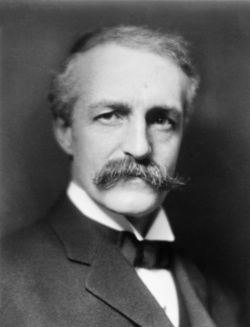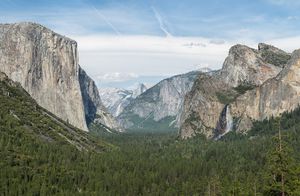Difference between revisions of "Why was the United States the first country to establish National Parks"
| Line 34: | Line 34: | ||
====Bibliography==== | ====Bibliography==== | ||
| + | * Carr, Ethan. <i>Wilderness by Design: Landscape Architecture and the National Park Service</i>. Lincoln: University of Nebraska Press, 1998. | ||
| + | * Fiege, Mark. <i>The Republic of Nature: An Environmental History of the United States</i>. Seattle: University of Washington Press, 2012. | ||
| + | * Hays, Samuel P. <i>Conservation and the Gospel of Efficiency: The Progressive Conservation Movement, 1890-1920</i>. Cambridge: Harvard University Press, 1959. | ||
| + | * Ise, John. <i>Our National Park Policy: A Critical History</i>. New York: Arno Press, 1961 | ||
| + | * Miller, Char. <i>Gifford Pinchot and the Making of Modern Environmentalism</i>. Washington, D.C.: Island Press, 2001. | ||
| + | * Runte, Alfred. <i>National Parks: The American Experience</i>. Lincoln: University of Nebraska Press, 1979. | ||
| + | * Spence, Mark David. <i>Dispossessing the Wilderness; Indian Removal and the Making of the National Parks</i>. New York: Oxford University Press, 1999. | ||
| + | * Steinberg, Ted. <i>Down to Earth: Nature's Role in American History</i>. New York: Oxford University Press, 2002. | ||
Revision as of 17:33, 3 June 2018
The idea of setting aside lands for what might be described as “nature recreation” has a long and storied history in many of the ancient civilizations of the world. Royal forests, sacred grounds surrounding temples, or village commons existed well before any American declared a patch of land a “national park.” What makes these tracts of land different, however, is both their intended use and their intended users. American national parks represent the culmination of several disparate ideas into one common desire to create a place for citizens to experience the natural world.
Historical Antecedents
Early in its usage, the word “park “contrasts with the ideal garden, which was a landscape designed for the pleasure of humans. First used as a Middle English word, “park” drew on German and French words related to pens, pen folds, and paddocks. The Oxford English Dictionary describes park as a word that “was originally a legal term designating land held by royal grant for keeping game animals: this was enclosed and therefore distinct from a forest or chase.” This distinction from a medieval forest is crucial, as “forests” at the time were wild places largely beyond the control of humans and left to their own natural progression whereas “parks” were for the pleasure of people who wanted to engage in recreation and subject to some level of land management. Furthering the human control over the space, the English example also introduces the gamekeeper, an individual employed by the property owner for the express purpose of managing the land in a way that encourages balance.
Thus from its earliest use, “park” indicated a special place, dedicated to the protection of a natural state of order, but crucially distinct from notions of true wilderness and necessarily managed by a gamekeeper. Wholesome and pastoral landscapes also did not compare to the “wilderness” of the American West. As one of the most frequently cited differences between American and European conceptions of natural recreational space, this relationship with “wilderness” and the protection of wild places is the distinguishing feature in the history of intensive management for the purposes of recreation and the relative human impact on the land.
Before the English arrived in North America, a tradition of enclosing land for the purpose of aristocratic recreation already existed in the English countryside, but this type of parkland evolved in a crowded countryside where few people owned land and the whole countryside was known to its residents. As the European tradition of country parks and gardens evolved in tandem with a heavily populated rural landscape these starting conditions influenced the way English parks developed. In places like England, France, and Germany, the evolution of a certain “natural” landscape that included spaces for recreation and commons areas throughout the countryside not only offers an alternative to the large parks of the American West, but in the Romantic era authors even ascribed to the landscape a sort of cultural determinism in addition to its natural beauty.
Conservation vs. Preservation
When the English colonists first started building towns on the North American continent, they recreated some of these earlier ways of treating land. New England towns often featured a “commons,” or an area that was protected from development but open to all villagers for common use. Southern plantations typically had vast acreages left out of the cycle of cultivation. This was as much a result of labor conditions in the South as anything else, but the effect was a sort of commons shared between settlers, slaves, and Native Americans. As the settlers continued moving west, tales emerged of the rugged frontiersman as the archetype of American exceptionalism. The self-reliance and ingenuity that were tested on the frontier translated into a strong and independent citizenry that served as the foundation of the new country’s political class. Names like Daniel Boone and Davy Crockett became synonymous with the American spirit, and their exploits on the frontier helped define what it meant to be an American folk hero.
As the American West was settled by European-Americans, it slowly lost many of the features that were considered necessary for the frontier experience. The modern world came crashing into places that otherwise were considered wild. As historians like Frederick Jackson Turner started declaring the frontier “closed” and the settlement of the West over, politicians worried about the potential for the decay and decline of American exceptionalism now that it was cut off from its traditional proving grounds. For some policy-makers, the solution was to continue expanding overseas through aggressive imperialism. For others, the conservation of natural resources or the preservation of wild lands at home would ensure the American people would have access to the frontier experience for generations to come.
Conservation refers to the desire to protect natural resources (including soil, water, and any valuable plants growing) from overuse or destruction. The champion of conservation was Gifford Pinchot, the Chief Forester of the United States and close adviser to Teddy Roosevelt. While conservation planning often resulted in the protection of natural areas, the primary focus of conservation is the protection of valuable natural resources for use in future. The forest is not protected so much for its inherent value as a place for plants and animals as it is grown like a crop of trees that will be cut down when future generations need them for lumber. This is perhaps best represented in the bureaucratic home for the US Forest Service, which is a subsidiary of the Department of Agriculture.
Preservation refers to the desire to protect natural areas from development in order to preserve the characteristics that make them unique and protect the species living there from human interference. When contrasted with conservation, preservation operates from the assumption that humans are simply one species on the planet and that other species have an equal right to exist. If people enter the spaces designated for preservation, they are expected to avoid changing them in any meaningful way. The “wilderness experience” is something to be protected for future generations, and as a result the protected land is managed.
Natural Monuments
Another significant contribution to the creation of national parks in the United States also comes from Americans looking to Europe, but in this case it was responsible for the creation of something new rather than copying a European tradition. When Americans visited Europe, the Middle East, and Asia there were struck by the massive monuments built by ancient civilizations. With a relatively young country and little desire to create pyramids, coliseums, or great walls, many Americans looked to the vast natural splendor of the West as their answer to Europe’s monuments.
Early parks like Yellowstone and Yosemite existed as unique examples of natural environments unlike anything else on the North American continent. With the passage of the 1906 Antiquities Act, presidential authority to set aside lands as national monuments further crystallized the idea that certain natural features of the United States were worthy of consideration as part of the country’s patrimony. After the creation of the National Park Service in 1916, the infrastructure of these parks continued to develop until ultimately average citizens visited the parks to see and experience their natural beauty.
Why America?
The idea of a national park needed a few things to happen simultaneously. First, the federal government held vast acreage in the American West, which made the creation of parks relatively easy compared to the patchwork of private land that existed in Europe (or even the American Eastern states, for that matter). As an example of this advantage, consider the number of acres held in national parks in the American West as compared to those in the east. Only two major national parks exist east of the Mississippi river, and these are located in areas that were less populated than much of the rest of the eastern seaboard.
Second, the United States was subject to the same Progressive Era ideals and fears of modernity that prompted other major reforms in the late 1800s. Conservation of natural resources and a uniquely American desire to preserve the frontier experience combined to create a national desire for places where Americans could experience “wilderness.” While these areas were largely located in places only the wealthy could afford to visit, the protection of rugged lands that were protected from the intrusion of modern life became its own democratic ideal as the country increasingly urbanized.
Finally, there was a very real sense of anxiety among American elites that the country needed something to serve as our own version of the cultural monuments that dominated Europe. The spectacular natural formations of the American West deserved protection, but they also represented American exceptionalism. If New York and Chicago could compete with European industry and technology, the ancient monuments of America could be found in the untamed wilderness of the American West. No other country could compete with American natural splendor, and as a result the United States combined the impulse to provide recreation space for the public, monuments for public display, and protecting some of the unique American frontier experience to create a system that the world emulates. National parks following the American model now exist on every inhabited continent. What began with Yellowstone in 1872 is now a globally shared common heritage.
Bibliography
- Carr, Ethan. Wilderness by Design: Landscape Architecture and the National Park Service. Lincoln: University of Nebraska Press, 1998.
- Fiege, Mark. The Republic of Nature: An Environmental History of the United States. Seattle: University of Washington Press, 2012.
- Hays, Samuel P. Conservation and the Gospel of Efficiency: The Progressive Conservation Movement, 1890-1920. Cambridge: Harvard University Press, 1959.
- Ise, John. Our National Park Policy: A Critical History. New York: Arno Press, 1961
- Miller, Char. Gifford Pinchot and the Making of Modern Environmentalism. Washington, D.C.: Island Press, 2001.
- Runte, Alfred. National Parks: The American Experience. Lincoln: University of Nebraska Press, 1979.
- Spence, Mark David. Dispossessing the Wilderness; Indian Removal and the Making of the National Parks. New York: Oxford University Press, 1999.
- Steinberg, Ted. Down to Earth: Nature's Role in American History. New York: Oxford University Press, 2002.


